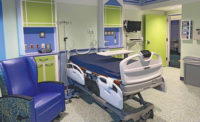
The health-care industry is on the brink of being overrun with oceans of digital data. Small, modular data centers may provide the best means for midsize operators, say experts who addressed the issue at the Greater Chicago Data Center Summit in early June.
In accordance with an Executive Order issued in 2004, health-care providers have until 2015 to incorporate electronic medical records into their operations or face penalties. While providers have been slow to adopt the technology, financial incentives included in the 2009 American Recovery and Reinvestment Act and Health Information Technology for Economic and Clinical Health Act are accelerating industry efforts to transition to digital record-keeping.
The question is where and how to store the resulting data, says Christopher Johnston, senior vice president, critical facilities, with engineer Syska Hennessy Group, Atlanta. “Most hospital data centers are atrocities,” he says. “The typical response among operators is, 'Oh, we forgot about that, but we've got a great spot for it in the basement.' ”
At the request of Children's Health Care, a three-facility, 1,000-bed operator in Atlanta, architect Gensler executed the design of a 4,000-sq-ft, 400-kw modular precast data center, a concept which midsize providers that wish “to own and control their own data center” could readily adopt, says Rick Sellers, senior associate with the firm's Atlanta office. “You can mount the mechanical units on the roof or pad-mount them on grade,” says Sellers. “And depending on the number of modules, parts of these facilities can grow independently of others.”
As digital data accumulates, “a well-thought-out, planned deliverable constructed from a standardized kit of parts allows end users to build in phases as needed,” agrees Bernard Woytek, senior associate with Gensler, Chicago.
“It's not a concept well suited to large health-care networks such as Kaiser Permanente,” says Johnston. “But hospital IT is very reactive—the gun is always at their heads—and a modular solution could work very well for those employed by smaller networks. It also removes the data center from the hospital's electrical system, which means you're going to have a far more reliable facility.”
The $6.2-million Children's facility is “completely precast” and required six weeks to design and fewer than six months to construct. Although equipped with 30 cabinets, the facility can accommodate as many as 156—sufficient to accommodate Children's needs for eight years or more, says Sellers.
The HVAC system, designed by engineer Morrison Hershfield Corp., Atlanta, incorporates indirect evaporative cooling, a solution that yields a favorable power-usage effectiveness since it requires substantially less energy than more conventional forms of refrigeration.



Post a comment to this article
Report Abusive Comment